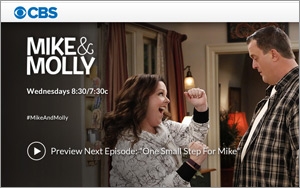
PASADENA, CALIF. -- Although many have talked up declining network TV viewing, CBS continues to cite new prime-time records when looking at all current platforms.
Speaking at the Television
Critics Association meeting here, Glenn Geller, president of CBS Entertainment, said: “More people are watching CBS shows than 15 years ago”-- repeating what other CBS executives have
previously stated.
CBS says there is a 6% increase for its average prime-time shows in the 2015-2016 season so far to 13.2 million viewers from 12.5 million in 2000-2001.
CBS’
data comes from comparing all current platforms -- DVR, video-on-demand, and online streaming -- in the 2015-2016 season through November 2015 versus linear-only TV in 2000-2001 through November 2000,
using Nielsen, Rentrak and CBS internal data.
advertisement
advertisement
In addition, Geller says that although there are a growing number of scripted TV shows -- 409 programs, according to an estimate from FX -- CBS
continues to lay claim to having the most viewed prime-time content. (FX said a growing number of programs means higher difficulty in getting viewers to support shows to be financially viable.)
Geller says CBS has six of the top 10 shows when looking at live program plus seven days of time-shifting viewing --- with “Big Bang Theory” (21.2 million) and “NCIS” (20.8
million) as the top two shows. AMC’s “Walking Dead” comes next at 19.5 million followed by Fox’ “Empire”, at 17.5 million.
Overall, network TV has 47
of the top 50 shows, according to CBS. In addition to “Walking Dead,” AMC’s “Fear The Walking Dead” (11.8 million) and HBO’s “Game of Thrones” (9.5
million) are the only other cable network shows in the top fifty.
Speaking about the TV advertising market, Geller went on to say that CBS’s scatter market continues to be healthy --
starting from the fourth quarter in 2015 and continuing into the current first-quarter period. As has been the historical trend in many years of the network TV advertising marketplace, Geller says
this should lead to a “strong” upfront market come this summer.
Geller ascended to the top spot in CBS Entertainment in September, following the departure of Nina Tassler, who held
the post for more than decade.
Geller, a 14-year veteran, says some of his programming strategy comes from a reality-TV point of view.
“Reality often defines a network,” he
says, referring to “Survivor” and “Amazing Race.” Geller says “The Voice” does this for NBC; “Dancing with the Stars” for ABC; and “American
Idol” for Fox.
In that regard, he says a new reality TV show is in development at CBS:“Hunted”. This is a U.K.-derived TV series in which a group of individuals are
“hunted” by professional law enforcement personnel. Should they last 28 days without getting captured, those contestants will each get $100,000.